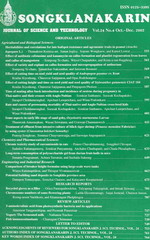ThaiScience
ThaiScience
SONGKLANAKARIN JOURNAL OF SCIENCE & TECHNOLOGY
Volume 42, No. 06, Month NOVEMBER, Year 2020, Pages 1286 - 1293
Iconographic correlation analysis for optimization of high caloric density enteral nutrition formulation
Tanathep Leungtongkum , Jirarat Anuntagool , Celine Leridon , Mohamad Hamoud-Agha and Jean-Claude Laguerre
Abstract Download PDF
High caloric density enteral nutrition contains high amounts of carbohydrates, proteins and fats. Therefore, it is likely to have either too high viscosity or unstable emulsion if not optimally formulated. Response surface methodology (RSM) is a tool for optimization. To obtain the optimal formula, numerous formulas are needed to be prepared and determined if classical RSM using a central composite design (CCD) is used since there are many involving factors. For this reason, the Iconographic Correlation (IC) could be compromising. In this study, 9 influencing factors were optimized. The desired response was the complex viscosity and a degree of emulsion separation. By using the IC, the number of experiments was reduced from 524 treatments if the CCD was used to 17 treatments. The model describing significant logical interactions between factors toward each response was proposed with excellent correlation, R2adj = 0.99, and 0.93 for complex viscosity, and emulsion separation, respectively.
Keywords
iconographic correlation, response surface methodology, optimization, enteral nutritionSONGKLANAKARIN JOURNAL OF SCIENCE & TECHNOLOGY
Published by : Prince of Songkla University
Contributions welcome at : http://rdo.psu.ac.th
